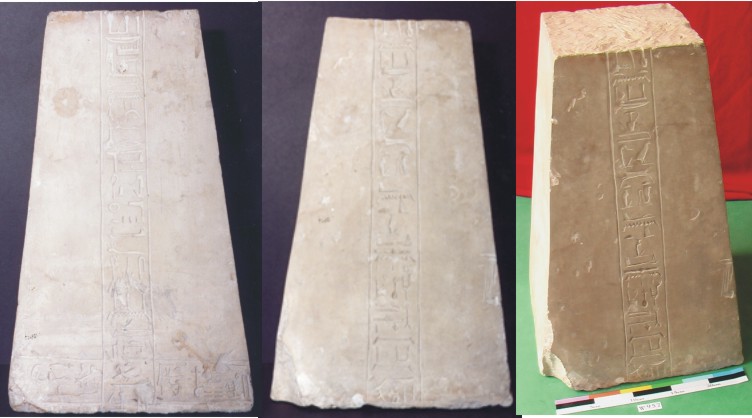W957
W957 Offering Table Belonging to Paneb
 This limestone base of an offering table is 42cm in height. The hieroglyphs indicate that it belonged to Paneb. The stand was probably set up in one of the small private chapels adjoining the village.
This limestone base of an offering table is 42cm in height. The hieroglyphs indicate that it belonged to Paneb. The stand was probably set up in one of the small private chapels adjoining the village.
The vertical text on the front is a dedication of offerings to Amun of the Perfect Encounter in order to obtain his blessing for Paneb. The horizontal text records the name of his father and son, Neferseret and Aapahate. On the rear is a dedication to Khnum, Satet and Anuket, gods of the first cataract region, who were held in particular honour by the workmen at Deir-el-Medina.
Quite a lot is known of this character from his destroyed tomb at Deir el-Medina and also from Egyptian papyrus, notably the Papyrus Salt 124 in the British Museum.
Paneb was one of the most colourful inhabitants of Deir el-Medina. The village was occupied by workmen who built the royal tombs in the Valley of the Kings and the Valley of the Queens. Paneb was born in the reign of Rameses II (1279-1213BC). He was brought up in the house of the foreman Neferhotep. When Neferhotep died Paneb became foreman. He lived a wild and disreputable life. He was given to fighting and drunkeness, seducing married women, stealing from royal tombs and threatening to murder Neferhotep. It is not known what happened to him. Soon after a number of charges were laid against him, he and his son Aapahate disappeared from Egyptian records, perhaps they were executed.
The offering table belonging to Paneb in the Egypt Centre (W957) has been published by Gareth Lucas (1998).
Further Reading
Bierbrier, M.L. 2000. Paneb Rehabilitated. In Demarée, R.J. and Egberts, A. Deir el-Medina in the Third Millennium AD. Leiden, 51-54.
Černý, J. 1929. Papyrus Salt 124 (Brit. Mus. 10055) Journal of Egyptian Archaeology 15, 234-253.
Lucas, G. 1998. Four Egyptian Pieces in the Wellcome Collection at Swansea, I. Göttinger Miszellen 167, 83-85.
Other items from Deir el-Medina in the Egypt Centre